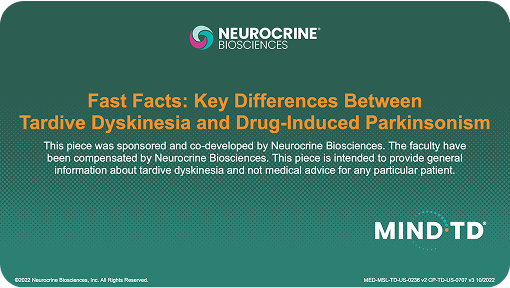

~2 mins
•Oct 2022
Key Differences Between Tardive Dyskinesia and Drug-Induced Parkinsonism



~2 mins
•Oct 2022


~5 mins
•Jan 2025


~10 mins
•Dec 2024
References
Savitt D, Jankovic J. J Neurol Sci. 2018;389:35-42.
D’Souza RS, Hooten WM. Extrapyramidal symptoms. In: StatPearls. Treasure Island (FL): StatPearls Publishing; August 3, 2021.
Hauser RA, Meyer JM, Factor SA, et al. Differentiating tardive dyskinesia: a video-based review of antipsychotic-induced movement disorders in clinical practice. CNS Spectr. 2022;27(2):208-217.
Factor SA, Burkhard PR, Caroff S, et al. Recent developments in drug-induced movement disorders: a mixed picture. Lancet Neurol. 2019;18(9):880-890.
Caroff SN, et al. Psychiatr Clin North Am. 2016;39(3):391-411.
Data on file. Neurocrine Biosciences Inc.
Caroff SN. Overcoming barriers to effective management of tardive dyskinesia. Neuropsychiatr Dis Treat. 2019;15:785-794.
Susatia F, Fernandez HH. Drug-induced parkinsonism. Curr Treat Options Neurol. 2009;11(3):162-169.
Ward KM, Citrome L. Antipsychotic-related movement disorders: drug-induced parkinsonism vs. tardive dyskinesia-key differences in pathophysiology and clinical management. Neurol Ther. 2018;7(2):233-248.
Hardie RJ, Lees AJ. Neuroleptic-induced Parkinson’s syndrome: clinical features and results of treatment with levodopa. J Neurol Neurosurg Psychiatry. 1988;51(6):850-854.
Tarsy D. Neuroleptic-induced extrapyramidal reactions: classification, description, and diagnosis. Clin Neuropharmacol. 1983;6(Suppl 1):S9-S26.
Shin HW, Chung SJ. Drug-induced parkinsonism. J Clin Neurol. 2012;8(1):15-21.
Fahn S, Jankovic J, Hallet M. The tardive syndromes: phenomenology, concepts on pathophysiology and treatment, and other neuroleptic-induced syndromes. In: Fahn S, Jankovic J, Hallet M, eds. Principles and Practice of Movement Disorders. 2nd ed. Saunders; 2011:415-446.
Caroff SN, Hurford I, Lybrand J, Campbell EC. Movement disorders induced by antipsychotic drugs: implications of the CATIE schizophrenia trial. Neurol Clin. 2011;29(1):127-148, viii.
Caroff SN, Citrome L, Meyer J, et al. A modified Delphi consensus study of the screening, diagnosis, and treatment of tardive dyskinesia. J Clin Psychiatry. 2020;81(2):19cs12983.
Lundt L, Jain R, Matthews D, et al. Development of a MIND-TD questionnaire as a screening tool for tardive dyskinesia. Poster presented at: Neuroscience Education Institute Congress; November 4-7, 2021; Colorado Springs, CO.
Psychiatry & Behavioral Health Learning Network. Can the AIMS exam be conducted via telepsychiatry? December 9, 2019. Accessed October 19, 2021. https://www.psychcongress.com/article/can-aims-exam-be-conducted-telepsychiatry
Hauser RA, Meyer JM, Factor SA, et al. Differentiating tardive dyskinesia: a video-based review of antipsychotic-induced movement disorders in clinical practice. CNS Spectr. 2022;27(2):208-217.
Lundt L, Jain R, Matthews D, et al. Development of a MIND-TD questionnaire as a screening tool for tardive dyskinesia. Poster presented at: Neuroscience Education Institute Congress; November 4-7, 2021; Colorado Springs, CO.